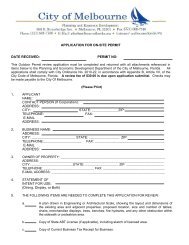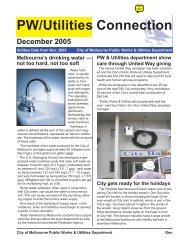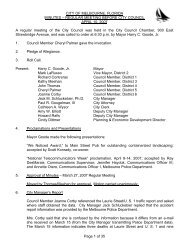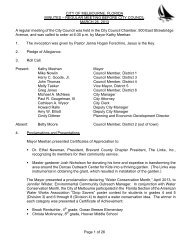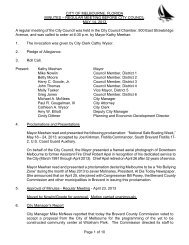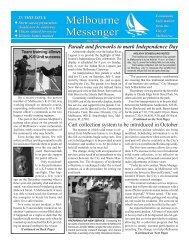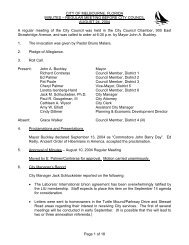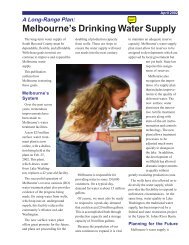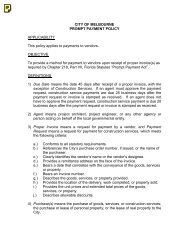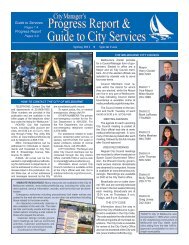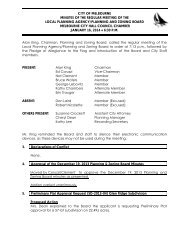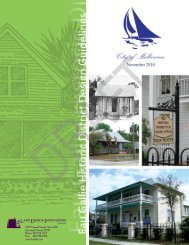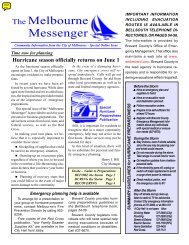Mar. 12 - City of Melbourne, Florida
Mar. 12 - City of Melbourne, Florida
Mar. 12 - City of Melbourne, Florida
Create successful ePaper yourself
Turn your PDF publications into a flip-book with our unique Google optimized e-Paper software.
Industrial pretreatment seeks to<br />
prevent the discharge <strong>of</strong> pollution<br />
(Continued from Front Page)<br />
operating costs while reducing their<br />
environmental liability and employee<br />
exposure to hazardous materials.<br />
Greer, who is active in statewide<br />
organizations that focus on industrial<br />
pollution prevention, played a key role<br />
in a recent revision <strong>of</strong> the <strong>Melbourne</strong><br />
ordinance that is designed to protect<br />
the reclamation plants. The ordinance<br />
was updated to ensure that the local law<br />
reflects changes in federal standards.<br />
The ordinance applies to all nonresidental<br />
wastewater discharges to the<br />
<strong>City</strong>’s treatment system and specifies<br />
which activities require permits.<br />
“It is important to note that all businesses<br />
are expected to comply with the<br />
requirements <strong>of</strong> the ordinance and meet<br />
the local limits,” Greer said. The level <strong>of</strong><br />
monitoring that is required for area businesses<br />
varies depending on the nature <strong>of</strong><br />
the industry and the risk <strong>of</strong> pollution that<br />
is posed by their operations.<br />
“My main focus with industrial<br />
wastewater is the metals content,” Greer<br />
explained. “Metals that we typically see<br />
when sampling include copper, chromium,<br />
lead, nickel, and zinc.<br />
“Probably the most common form <strong>of</strong><br />
pretreatment in <strong>Melbourne</strong> and across<br />
the country is pH neutralization.” pH is<br />
a measurement <strong>of</strong> water that indicates a<br />
level <strong>of</strong> acidity.<br />
Greer is available to assist local businesses<br />
and other pretreatment programs<br />
with pollution prevention information<br />
and regulatory assistance. He recommends<br />
a voluntary certification program<br />
<strong>of</strong>fered by the <strong>Florida</strong> Industrial Pretreatment<br />
Association. A ‘FOG’ (fats, oils<br />
& grease) management course is also<br />
available for grease trap inspectors and<br />
those in the food industry.<br />
PUBLICATION <strong>of</strong> a book<br />
about ‘<strong>Melbourne</strong>’s Logging<br />
Era: 19<strong>12</strong>-1932,’ has provided<br />
an addition to local history<br />
references. <strong>Melbourne</strong><br />
author Ed Vosakta provides<br />
details and photos about<br />
the railroad and lumber mill<br />
that moved the area into<br />
the industrial age. The book is the second<br />
about <strong>Melbourne</strong> in an ‘Images <strong>of</strong> America’<br />
series published by Arcadia Publishing. The<br />
publication is available at local retailers and<br />
online at www.arcadiapublishing.com.<br />
Area history information is available at<br />
melbourneflorida.org/history.<br />
Arbor Day ceremony encourages tree plantings<br />
The recent celebration <strong>of</strong> Arbor Day<br />
in <strong>Melbourne</strong> provided an opportunity for<br />
renewed attention to the numerous benefits<br />
<strong>of</strong> trees, reflected in a proclamation read by<br />
Vice Mayor Mike Nowlin.<br />
‘Trees increase property values, enhance<br />
economic vitality <strong>of</strong> business areas, and<br />
beautify our community,’ the proclamation<br />
notes, also pointing to the importance <strong>of</strong><br />
foliage in moderating temperatures, producing<br />
oxygen,<br />
and providing<br />
wildlife<br />
habitat.<br />
The ceremony<br />
was<br />
hosted by<br />
<strong>Melbourne</strong>’s<br />
Environmental<br />
and<br />
Sally Scalera, horticulturist<br />
with the Brevard County Extension<br />
Service, described<br />
popular trees during a presentation<br />
in <strong>Melbourne</strong>.<br />
Beautification<br />
Advisory<br />
Committee, a<br />
group <strong>of</strong> volunteers<br />
that<br />
make recommendations to the <strong>City</strong> Council.<br />
The committee’s activities, along with the<br />
<strong>City</strong>’s tree ordinance, contribute to <strong>Melbourne</strong>’s<br />
recognition as a ‘Tree <strong>City</strong> U.S.A.’<br />
by the national Arbor Day Foundation.<br />
The tree ordinance establishes guidelines<br />
for the protection and addition <strong>of</strong> trees when<br />
The VALUE OF TREES was<br />
the topic for <strong>Melbourne</strong>'s Arbor<br />
Day, with a ceremonial planting<br />
at Wells Park by (from left), Ronald<br />
Strandjord, <strong>City</strong> Manager<br />
Jack Schluckebier, <strong>City</strong> Council<br />
Member <strong>Mar</strong>k LaRusso, Vice<br />
Mayor Mike Nowlin, <strong>City</strong> Council<br />
Member Kathy Meehan, and<br />
Celeste Henry, vice chair <strong>of</strong> the<br />
committee hosting the event.<br />
Mr. Strandjord also serves on<br />
the committee. The annual ceremony<br />
included distribution <strong>of</strong><br />
free tree seedlings.<br />
(Continued from the Front Page)<br />
reflects the intent <strong>of</strong> the state law, which requires<br />
motorists to take action to prevent collisions<br />
with emergency vehicles stopped along roadways.<br />
It is an effort to help protect motorists as<br />
well as police and emergency workers<br />
Motorists are expected to slow down and<br />
continue driving at a safe speed, and are directed<br />
to avoid stopping in the roadway or blocking the<br />
flow <strong>of</strong> traffic.<br />
On a two-lane roadway, when approaching<br />
an emergency vehicle parked on the side <strong>of</strong><br />
the road with lights flashing, a driver must slow<br />
down to 20 miles per hour below the posted<br />
property is developed. Dan Porsi, the <strong>City</strong>’s<br />
Code Enforcement Administrator, explained<br />
that careful selection <strong>of</strong> trees allows both<br />
developers and homeowners to maximize<br />
benefits.<br />
“We recommend that trees be selected<br />
that are indigenous, native species,” Porsi<br />
said. “One important factor is the choice <strong>of</strong><br />
trees that will thrive with average rainfall<br />
after they are established, so you can avoid<br />
ongoing irrigation.<br />
“We also encourage the careful placement<br />
<strong>of</strong> the plants so that they are not too<br />
close to structures or power lines. That could<br />
result in the need to remove them later, or<br />
severely prune them,” Porsi said.<br />
Questions about tree selections and<br />
cultivation are <strong>of</strong>ten answered by Sally Scalera,<br />
Horticulture Agent II with the Brevard<br />
County Extension Service <strong>of</strong>fice in Cocoa.<br />
Scalera divides the recommended tree<br />
species into three groups according to their<br />
eventual size.<br />
The tree lists and links to other information<br />
from the extension service are available<br />
through the <strong>City</strong>’s website (melbourneflorida.<br />
org/leisure/arborday.htm).<br />
The information includes recommendations<br />
on which trees to select for particular<br />
locations, developed by the Institute <strong>of</strong> Food<br />
and Agricultural Sciences at the University<br />
<strong>of</strong> <strong>Florida</strong>.<br />
State’s ‘Move Over’ law seeks to make highways safer<br />
speed limit unless directed to do otherwise by an<br />
emergency worker on the scene.<br />
On an interstate highway or roadway with<br />
multiple lanes <strong>of</strong> travel in the same direction, a<br />
driver who is approaching an emergency vehicle<br />
with lights flashing must vacate the lane closest<br />
to that vehicle as soon as it is safe to do so.<br />
A driver who is unable to safely move over<br />
must slow to a speed <strong>of</strong> 20 miles per hour below<br />
the posted speed limit, unless directed otherwise<br />
by a law enforcement <strong>of</strong>ficer.<br />
Additional information is available online<br />
from the <strong>Florida</strong> Highway Patrol website at<br />
www.flhsmv.gov/safetytips/MoveOverTips.htm.



